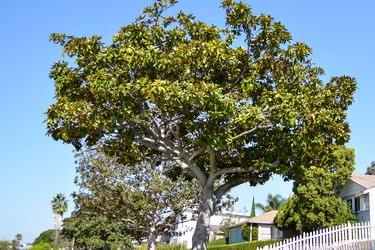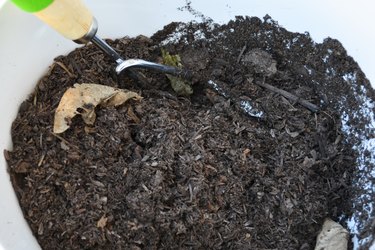
Languid spring or summer afternoons, fragrant with the scent of magnolia (Magnolia spp.) blossoms, may present an idealized vision of Southern living, but the reality of these breathtaking trees is quite different. Depending on variety, magnolia trees handle conditions from the northern winters of U.S. Department of Agriculture plant hardiness zones 3 through the sultry summers of USDA zone 9. If you grow them, use suitably timed fertilizer applications to keep the trees at their flamboyantly blooming best.
Magnolia Trees and Soil pH
Video of the Day

Magnolias like moderately acidic soils with a pH of 5.0 to 6.0, and no fertilizer can help them if a higher pH is interfering with their mineral absorption. If a home soil test kit indicates you soil's pH needs lowering, amend it with elemental sulfur at least three months before planting the trees. In fall or early winter, scatter 2 pounds -- or the manufacturer's recommended amount for your soil type -- of sulfur evenly over each 100 square feet of soil and till it 6 inches to 1 foot deep. To acidify the soil around an existing magnolia, work 1/2 pound of sulfur into the top 1 inch of soil for every 100 square feet. Test the pH every four to six weeks and repeat as needed.
Video of the Day
Fertilizing at Planting

Once your soil's pH is right, amend it with well-aged compost at planting time. Compost substitutes for the humus wild magnolias find in their natural woodland habitats. In addition to improving drainage, it feeds the bacteria that make soil nutrients accessible to the roots. Mix 1 part compost to 3 parts of the soil excavated from the planting holes and use it to backfill around the roots.
Maintenance Fertilizing

Don't fertilize your magnolias at all during the first year after planting. Starting in their second spring and for the next three years, feed them with organic, 5-5-5 granulated fertilizer every other month from March through September. After the fourth year, cut back to March and July feedings. Feed them with 1/2 cup, or the label's specified amount, of granules for each 2 feet of height. Scatter the fertilizer evenly over the soil. Keep it 1 foot from the trunks and spread it to their drip lines, where rain falls from the outermost branches. Scratch it lightly into the surface and water well.
Managing Iron Deficiency

If your magnolias' new leaves are smaller than normal, with green veins against a pale yellow background, suspect iron deficiency. It's due to inadequate iron absorption in high-pH or overly wet soil. For a short-term remedy, spread 1/3 to 1/2 ounce, or the label's suggested amount, of 100-percent chelated Fe-EDDHA granules per 10 square feet, spread over the surface of the root zone. Make the first application before the tree leafs out in spring. Starting 1 foot from the trunk, work out to the drip line and water the granules in. It may require several treatments to restore the leaves' color, and the effects last only one or two years. To prevent future iron deficiency, lower your soil's pH with elemental sulfur and water less.